Elymus californicus is a species of wild rye known by the common name California bottlebrush grass. This grass is endemic to California where it is an uncommon species known from a few counties in the San Francisco Bay Area. It grows between one and two meters in height. The tall, erect stem is nearly naked, bearing the occasional sheathing leaf with a blade 10 to 20 centimeters long. It bears an erect inflorescence which curves as it becomes heavier in grain. Each inflorescence is divided into three or four nodes with three or four spikelets per node. Each spikelet is between one and two centimeters long, not counting a long awn about two centimeters long.

Eragrostis cilianensis is a species of grass known by several common names, including stinkgrass, candy grass, and gray lovegrass.
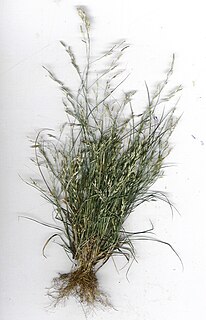
Eragrostis pectinacea is a species of grass known by the common name tufted lovegrass. This plant is native to the Americas from Canada to Argentina. It is widespread, growing in most open spaces at varying elevations and habitats, including in disturbed areas and roadsides.
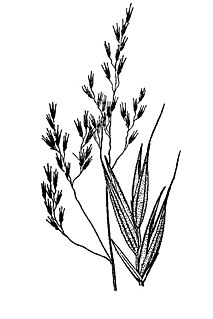
Festuca elmeri is a species of grass known by the common names coast fescue and Elmer's fescue. It is a bunchgrass native to the US states of California and Oregon, where it often grows in wet, shady areas in coastal counties.

Achnatherum latiglume is a species of grass known by the common names wide-glumed needlegrass and Sierra needlegrass.

Achnatherum lettermanii is a species of grass known by the common name Letterman's needlegrass. The updated and accepted name is Stipa lettermanii. It is native to the western United States from California to Montana to New Mexico, where it is a resident of several types of habitat.

Stipa parishii, formerly classified as Achnatherum parishii, is a species of grass known by the common name Parish's needlegrass. The Jepson Manual 2nd edition (2012) reclassified the plant as Stipa parishii var. parishii.
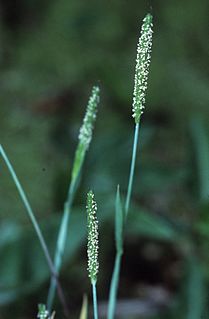
Alopecurus carolinianus is a species of grass known by the common names Carolina foxtail and tufted foxtail.

Alopecurus saccatus is a species of grass known by the common name Pacific foxtail, or Pacific meadow foxtail.
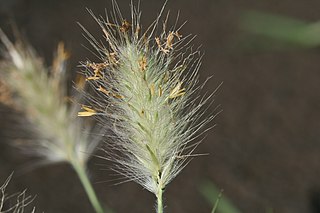
Pennisetum villosum is a species of flowering plant in the grass family Poaceae, known by the common name feathertop grass or just feathertop. It is native to northeastern Africa and parts of the Arabian Peninsula, and it is grown elsewhere as an ornamental plant. It can sometimes be found growing wild where it has escape cultivation. This is a perennial grass growing in rhizomatous clumps, producing erect stems up to about 75 centimeters tall. The inflorescence is a panicle of clustered spikelets surrounded by a cloudlike mass of plumose white bristles up to 5 centimeters long.

Setaria verticillata is a species of grass known by the common names hooked bristlegrass, rough bristle-grass and bristly foxtail. It is native to Europe, but it is known on most continents as an introduced species and often a noxious weed. It is a hardy bunchgrass which grows in many types of urban, cultivated, and disturbed habitat. It is a weed of many types of agricultural crops, growing in vineyards and fields. Herbicide-resistant strains have been noted.

Setaria viridis is a species of grass known by many common names, including green foxtail, green bristlegrass, and wild foxtail millet. It is sometimes considered a subspecies of Setaria italica. It is native to Eurasia, but it is known on most continents as an introduced species and is closely related to Setaria faberi, a noxious weed. It is a hardy grass which grows in many types of urban, cultivated, and disturbed habitat, including vacant lots, sidewalks, railroads, lawns, and at the margins of fields. It is the wild antecedent of the crop foxtail millet.
Torreyochloa erecta is a species of grass known by the common name spiked false mannagrass. It is native to the Cascade Range and Sierra Nevada ranges, its distribution extending from California north into Oregon and east into Nevada. It grows in mountain forests and the margins of lakes and streams, at elevations above 2000 meters. It is a rhizomatous perennial grass producing thick, erect stems up to about 60 centimeters in maximum height. The inflorescence is a narrow panicle much longer than wide, containing wide, compressed spikelets containing 4 to 6 florets each.
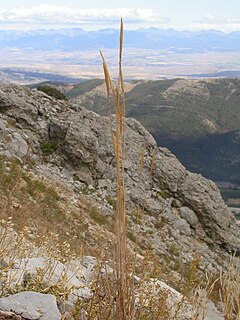
Trisetum spicatum is a species of grass known by the common name spike trisetum and spike false oat. It is native to North America, Eurasia, and South America. In North America it occurs throughout northern regions, including northern sections of the United States and most all of Canada, its range continuing to Greenland. It is widespread throughout the Canadian Arctic Islands. The grass occurs in a variety of Arctic and alpine habitat types, as well as many types of mountainous habitat in regions farther south. It is a perennial grass forming clumps of erect stems ranging in height from just a few centimeters to over one meter. The narrow leaves are mostly located around the bases of the densely clumped stems. The inflorescence is a narrow spike a few centimeters long or up to 30 to 50 centimeters in maximum length. The spikes are green to purple or brownish and shiny.

Trisetum wolfii is a species of grass known by the common names Wolf's trisetum and Wolf's false oat. It is native to western North America, including southwestern Canada and the western United States. It occurs in mountain habitat at moderate to high elevations below the tree line, such as spruce, fir, and aspen stands. It is a perennial grass forming clumps of erect stems growing up to about 80 centimeters in maximum height, occasionally reaching one meter. The narrow leaves are mostly located on the lower third of the clumped stems. The inflorescence is a narrow, erect panicle with spikelets green, brownish, or purple in color.

Achnatherum thurberianum is a species of grass known by the common name Thurber's needlegrass. It is native to the western United States, where it occurs from Washington to California and east to Montana and Wyoming.
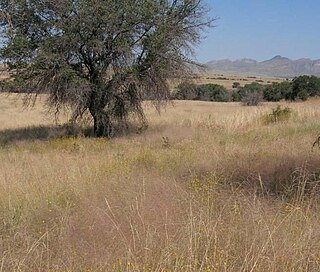
Eragrostis intermedia is a species of grass known by the common name plains lovegrass. It is native to North and Central America, where it is distributed from the southeastern and southwestern United States south to Costa Rica. Its range may extend to South America.
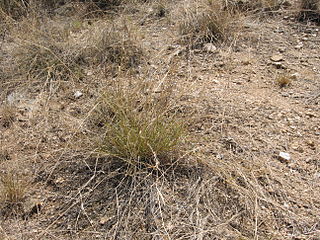
Eragrostis lehmanniana is a species of grass known by the common name Lehmann lovegrass. It is native to southern Africa. It is present elsewhere as an introduced species. It is well known as an invasive weed in some areas, such as Arizona in the United States.

Eragrostis pilosa is a species of grass. It is native to Eurasia and Africa. It may or may not be native to North America. It is widely introduced, and it is a common weed in many areas.

















